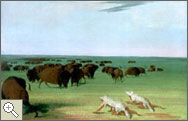
by Evelyn Porreca Vuko
Grades 3-5
In this lesson, students use their visualizing and interpreting skills to produce original writings and artwork. In Part One, they listen to an adaptation of William Clark's description of the sage grouse. As you read aloud, they form mental images that they translate into drawings of the bird.
In Part Two, Meriwether Lewis's observations of the black woodpecker, now called Lewis's woodpecker, might serve as inspiration for the students' descriptions of animals. Ideally, each student could choose an animal to write about on a field trip to a zoo or a museum of natural history. If this is not possible, pets or even pictures of animals will do. Students might even describe animals they have created out their own imaginations.
Objectives
- To explore differences in how the students visualize and interpret language
- To reinforce descriptive and sequential writing ability
- To link active and practical learning to historical figures
Materials
- Unlined paper
- Pencils
- Crayons or markers in brown, black, red, and yellow
- Printouts of Your animal
Part One
(30-35 minutes)
- Explain to students that you will read a description of an animal, which they will then try to draw.
- Let them know that William Clark wrote the description, but do not name or define the animal yet. Tell them you will read it twice: the first time to help them form an image of it, then again to "guide" their hands as they draw it. They should stop drawing when you finish reading the second time. Let them know that accuracy is more important than artistic talent.
- Read the following paragraph aloud twice. Ask them to draw the animal as if viewing it from the side.
This bird is nearly the size of a turkey. The beak is thick and short. The top of the beak is bigger than the bottom. The nostrils are large. This bird is covered with feathers that are mostly dark brown with shades of red and yellow mixed in. The feathers are also speckled with black. Its wings are only dark brown. The tail is long and comes to a very sharp point. The legs of the bird are covered with feathers down to about half the distance between the knee and the foot. It has four pointed toes on each foot. The back toe is the shortest of all.
- Ask students to stop drawing now.
- Show the picture of Clark's sage grouse
- You might point out that Lewis and Clark were the first American citizens to describe it for science—the first, in fact, to see it. Ask students to compare their drawings to Clark's. How are they alike? How are they different? What might Clark have said—or said better—to make the description clearer? Seeing errors in the drawings might lead students to a good critique of the description. Did they notice that Clark didn't describe the eyes? Did they draw eyes anyway?
Part Two
(40 minutes)
- Distribute copies of Your animal
- Explain that this is a description of a black woodpecker written by Meriwether Lewis, which each student can use as a kind of guide to write his or her own detailed description of an animal.
- Assist students who need additional reading and comprehension support. Allow the class 30-35 minutes to complete the exercise.
- For a homework assignment, ask each student to make a drawing based on his or her own description. To gauge the clarity and detail of the description, the student might read it aloud as another student tries to draw the animal.
|
 |
 |
 |

I do not think I exaggerate when I estimate the number of Buffaloe which could be compre[hend]ed at one view to amount to 3000.
--MERIWETHER LEWIS
|
 |
 |
 |
 |
 |
 |

Buffalo Hunt Under the Wolf-Skin Mask by George Catlin, 1846-1848.
|
 |
 |

Smithsonian American Art Museum; gift of Mrs. Joseph Harrison, Jr.
|
 |
 |
 |
|

